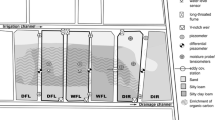Abstract
Characterizing water use and management in irrigated agriculture is a prerequisite for conserving agricultural water. We carried out a detailed analysis of irrigation performance by documenting the water use of about 840 parcels in an irrigation scheme (Genil–Cabra irrigation scheme; GCIS) located in Andalusia, southern Spain, from 1996 to 2000. Performance indicators based on the water balance detected two water-management strategies, depending on the crop: (1) cotton, garlic, maize and sugar beet had average ratios of measured irrigation supply to the simulated optimum demand (ARIS) ranging between 0.73 and 0.91 and (2) winter cereals, sunflower and olive had a much lower average ARIS (with a 4-year average of 0.28–0.39). We found a large variability in water usage among the management units in all cases. For instance, in cotton, even though the average ARIS was around 0.8, about 50% of the fields were not irrigated adequately (41% with deficit, 9% with excess). Water productivity (WP) in the GCIS was highest for the horticultural crops (garlic, olive; from 1.13 €/m3 to 6.52 €/m3) while it varied among the field crops, being lowest in maize (4-year average of 0.28 €/m3) and highest in sugar beet (4-year average of 1.04 €/m3). Large year-to-year variations in WP were observed in all crops, particularly in sunflower and garlic due either to fluctuating prices for garlic or to the effects of the 1998/1999 drought for sunflower. In fact, WP was lowest in all crops in that year, because seasonal irrigation depths were much higher than in the other 3 years. The combination of ARIS and other performance indicators allowed for determining performance levels and improvement measures. It was found that if more irrigation water is used in the GCIS, garlic and olive will be the crops that profit most from the additional supply. However, it was concluded that, given the wide range in water use and management encountered at the parcel level, improvement policies at the scheme level should always consider individual performance when designing measures for water conservation in irrigated agriculture.





Similar content being viewed by others
References
Allen RG, Pereira LS, Raes D, Smith M (1998) Crop evapotranspiration: guidelines for computing crop water requirements. (FAO Irrigation and Drainage Paper 56) FAO, Rome
Buller O, Manges HL, Stone LR, Williams R (1991) Modeled crop water use and soil water drainage. Agric Water Manage 19:117–134
Burt CM, Styles SW (1999) Modern water control and management practices in irrigation. Impact on performance. (Water Report 19) FAO, Rome
Clement R (1966) Calcul des debits das les reseaux d’irrigation fonctionnant la demande. La Houille Blanche 5:553–575
Coelho MB, Villalobos FJ, Mateos L (2003) Modeling root growth and the soil–plant–atmosphere continuum of cotton crops. Agric Water Manage 60:99–118
Doorenbos J, Kassam AH (1979) Yield response to water. (FAO Irrigation and Drainage paper 33) FAO, Rome
Droogers P, Bastiaanssen W (2002) Irrigation performance using hydrological and remote sensing modeling. J Irrig Drain Eng ASCE 128:11–18
Faci JM, Bensaci A, Slatni A, Playán E (2000) A case study for irrigation modernisation. I. Characterisation of the district and analysis of water delivery records. Agric Water Manage 42:313–334
Fereres E, Ceña F (1997). Social benefits and environmental constraints of irrigation in an era of water scarcity. In: Kay M, Franks T, Smith L (eds) Water: economics, management and demand. Chapman and Hall, London, pp 128–136
Heinemann AB, Hoogenboom G, Faria RT de (2002) Determination of spatial water requirements at county and regional levels using crop models and GIS. An example for the State of Parana, Brazil. Agric Water Manage 52:177–196
Howell TA (2001) Enhancing water use efficiency in irrigated agriculture. Agron J 93:281–289
Kloezen WH, Garcés-Restrepo C (1998) Assessing irrigation performance with comparative indicators: the case of the Alto Rio Lerma Irrigation District, Mexico. (Research Report 22) Irrigation Water Management Institute, Colombo, Sri Lanka
Lorite IJ, Mateos L, Fereres E (2004) Evaluating irrigation performance in a Mediterranean environment. I. Model and general assessment of an irrigation scheme. Irrig Sci (in press)
Malano H, Burton M (2001) Guidelines for benchmarking performance in the irrigation and drainage sector. International Programme for Technology and Research in Irrigation and Drainage (FAO), Rome
Mantovani EC, Villalobos FJ, Orgaz F, Fereres E (1995) Modelling the effects of sprinkler irrigation uniformity on crop yield. Agric Water Manage 27:243–257
MIMAM (1998) El libro blanco del agua en España. Ministerio de Medio Ambiente, Madrid
Molden DJ, Gates TK (1990) Performance measures for evaluation of irrigation-water-delivery systems. J Irrig Drain Eng 116:804–823
Molden DJ, Sakthivadivel R (1999) Water accounting to assess use and productivity of water. Water Res Devel 15:55–71
Molden DJ, Sakthivadivel R, Perry CJ, Fraiture C de, Kloezen WH (1998) Indicators for comparing performance of irrigated agricultural systems. (Research Report 20) International Water Management Institute, Colombo, Sri Lanka
Palmer JD, Clemmens AJ, Dedrick AR, Replogle JA, Clyma W (1991) Delivery systems performance case study: Welton Mohawk irrigation and drainage district. Irrig Drain Syst 5:89–109
Seckler D (1996) The new era of water resources management: from ‘dry’ to ‘wet’ water savings. (Research Report 1) International Irrigation Management Institute, Colombo, Sri Lanka
Villalobos FJ, Testi L, Rizzalli R, Orgaz F (2004) Evapotranspiration and crop coefficients of irrigated garlic (Allium sativum L.) in a semi-arid climate. Agric Water Manage 64:233–249
Williams JR (1991) Runoff and water erosion. In: Hanks J, Ritchie JT (eds) Modeling plant and soil systems. ASA/CSSA/SSSA, Madison, Wis., pp 439–455
Acknowledgements
The authors would like to thank the support provided by Mr. Berlanga (District Manager) and by the farmers of the Genil–Cabra irrigation scheme. Dr. Orgaz provided advice on crop responses to irrigation in the area. The study was supported by grant CICYT HID96-1380 of the Spanish Ministry of Education and Science.
Author information
Authors and Affiliations
Corresponding author
Additional information
Communicated by A. Kassam
Rights and permissions
About this article
Cite this article
Lorite, I.J., Mateos, L. & Fereres, E. Evaluating irrigation performance in a Mediterranean environment. Irrig Sci 23, 85–92 (2004). https://doi.org/10.1007/s00271-004-0096-8
Received:
Accepted:
Published:
Issue Date:
DOI: https://doi.org/10.1007/s00271-004-0096-8




